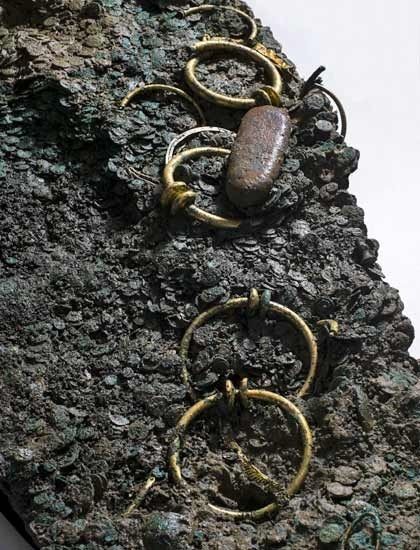Post by UKarchaeology on Nov 27, 2015 15:21:52 GMT

Ancient links between northern France and the Channel Islands are demonstrated by the hoard © Jersey Heritage
* Archaeologists allow public to see important phase of conservation work on remarkable Le Catillon II Hoard
Peeling back the top five centimetres of a pile of 71,000 coins buried in a field 2,000 years ago, archaeologists in Jersey are preparing to carefully extract a layer of gold jewellery in a specially-constructed laboratory at La Hougue Bie Museum, in the Jersey parish of Grouville.
The museum is currently in the middle of a week-long opening, allowing the public to watch conservator Neil Mahrer and his team preserve the coins, which have been re-dated to between 30-40 BC.
They are largely French but contain a number from the south coast of England, with torques, a “beautifully-crafted” silver ring, a small blue bead and a square centimetre fragment of woven cloth also emerging from the magnificent hoard.
Archaeologists allow public to see important phase of conservation work on remarkable Le Catillon II Hoard
A photo of two large mud-covered coins from the Jersey archaeological Hoard
The Jersey Hoard is the world's largest collection of Celtic coins© Jersey Heritage
Peeling back the top five centimetres of a pile of 71,000 coins buried in a field 2,000 years ago, archaeologists in Jersey are preparing to carefully extract a layer of gold jewellery in a specially-constructed laboratory at La Hougue Bie Museum, in the Jersey parish of Grouville.
The museum is currently in the middle of a week-long opening, allowing the public to watch conservator Neil Mahrer and his team preserve the coins, which have been re-dated to between 30-40 BC.
They are largely French but contain a number from the south coast of England, with torques, a “beautifully-crafted” silver ring, a small blue bead and a square centimetre fragment of woven cloth also emerging from the magnificent hoard.
A photo of two large mud-covered coins from the Jersey archaeological Hoard
Ancient links between northern France and the Channel Islands are demonstrated by the hoard© Jersey Heritage
"When we began the disassembly of the hoard we didn't know how much jewellery it contained as we could only see a couple of pieces poking out,” says Mahrer, who first heard about the treasure when it was found by metal detectorists Richard Miles and Reg Mead in June 2012.
“The hoard is too thick to x-ray so we literally found each piece one by one as we removed the coins atop and around them.
"We have revealed them all over a 12-month period, but we have left them in place until the whole layer was clear and we could laser scan them in situ before removing them.
Full story: www.culture24.org.uk/history-and-heritage/archaeology/art541941-jersey-museum-hoard-la-hougue-bie-museum
